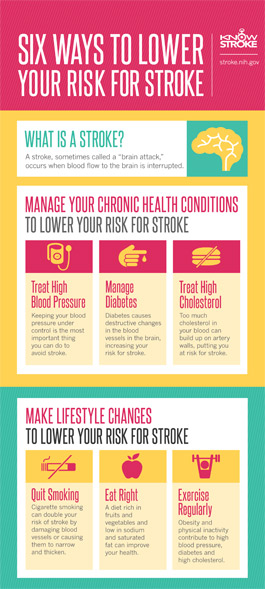WiRED Observes National Stroke Month
BY ALLISON KOZICHAROW; EDITED BY BERNICE BORN
M

(click to enlarge)
ay is National Stroke Month. Every year 15 million people worldwide suffer a stroke, yet stroke is both preventable and treatable.
Stroke is the brain equivalent of a heart attack, and can affect people of all ages and backgrounds. A stroke occurs when the flow of oxygen-rich blood to a portion of the brain is blocked, usually because a blood vessel bursts or is obstructed by a clot. Without oxygen, brain cells start to die after a few minutes. The effects of a stroke depend on which part of the brain is injured and how severely it is affected. A very severe stroke can cause sudden death.
WiRED International created a three-part series of modules on stroke that covers basic information, risks, signs, symptoms, treatment, complications and prevention. WiRED also offers several modules related to strokes, including a module on hypertension (in English and Mandarin) and a module on gestational hypertension. Hypertension, or high blood pressure, is often associated with stroke, as these modules describe.
National Stroke Month is a good time to check out WiRED’s modules on stroke and hypertension. Also, make a pledge to reduce your stroke risk factors by quitting tobacco, reducing drinking, being physically active, reducing weight and maintaining a heart-healthy diet.

You can download the modules in this story, and all 400+ of our health modules, through WiRED’s Health Module Access Program (HealthMAP) by clicking here. This easy to use program will enable you to create your own customized library of health education training modules. You can learn more about HealthMAP through WiRED's animation.
Signs of Stroke in Men and Women
- Sudden numbness or weakness in the face, arm, or leg, especially on one side of the body
- Sudden confusion, trouble speaking, or difficulty understanding speech
- Sudden trouble seeing in one or both eyes
- Sudden trouble walking, dizziness, loss of balance, or lack of coordination
- Sudden severe headache with no known cause
Call 9-1-1 right away if you or someone else has any of these symptoms.
Acting F.A.S.T. Is Key for Stroke
Acting F.A.S.T. can help stroke patients get the treatments they desperately need. The most effective stroke treatments are available only if the stroke is recognized and diagnosed within three hours of the first symptoms. Stroke patients may not receive the most effective treatments if they don’t arrive at the hospital in time.
If you think someone may be having a stroke, act F.A.S.T. and use the following simple test:
F—Face: Ask the person to smile. Does one side of the face droop?
A—Arms: Ask the person to raise both arms. Does one arm drift downward?
S—Speech: Ask the person to repeat a simple phrase. Is their speech slurred or strange?
T—Time: If you observe any of these signs, call for emergency help immediately.
Note the time when any symptoms first appear. Some treatments for stroke work only if given in the first three hours after symptoms appear. If you think you are having a stroke, do not drive to the hospital or let someone else drive you. Instead, call an ambulance so that medical personnel can begin life-saving treatment on the way to the emergency room.
Source: Centers for Disease Control and Prevention

^ Back to the Top
|





